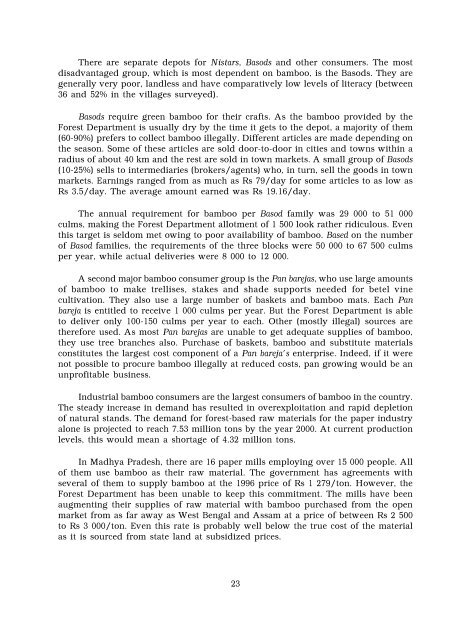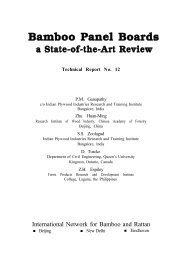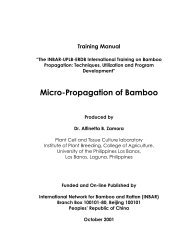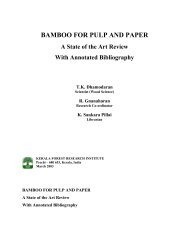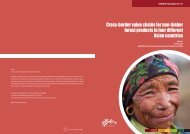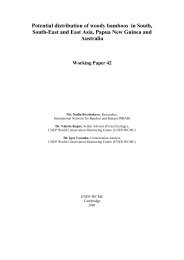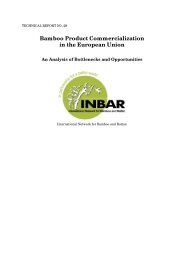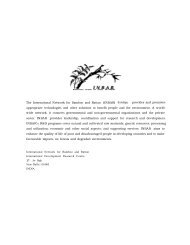The Bamboo and Rattan Sectors in Asia: an Analysis of ... - INBAR
The Bamboo and Rattan Sectors in Asia: an Analysis of ... - INBAR
The Bamboo and Rattan Sectors in Asia: an Analysis of ... - INBAR
Create successful ePaper yourself
Turn your PDF publications into a flip-book with our unique Google optimized e-Paper software.
<strong>The</strong>re are separate depots for Nistars, Basods <strong><strong>an</strong>d</strong> other consumers. <strong>The</strong> most<br />
disadv<strong>an</strong>taged group, which is most dependent on bamboo, is the Basods. <strong>The</strong>y are<br />
generally very poor, l<strong><strong>an</strong>d</strong>less <strong><strong>an</strong>d</strong> have comparatively low levels <strong>of</strong> literacy (between<br />
36 <strong><strong>an</strong>d</strong> 52% <strong>in</strong> the villages surveyed).<br />
Basods require green bamboo for their crafts. As the bamboo provided by the<br />
Forest Department is usually dry by the time it gets to the depot, a majority <strong>of</strong> them<br />
(60-90%) prefers to collect bamboo illegally. Different articles are made depend<strong>in</strong>g on<br />
the season. Some <strong>of</strong> these articles are sold door-to-door <strong>in</strong> cities <strong><strong>an</strong>d</strong> towns with<strong>in</strong> a<br />
radius <strong>of</strong> about 40 km <strong><strong>an</strong>d</strong> the rest are sold <strong>in</strong> town markets. A small group <strong>of</strong> Basods<br />
(10-25%) sells to <strong>in</strong>termediaries (brokers/agents) who, <strong>in</strong> turn, sell the goods <strong>in</strong> town<br />
markets. Earn<strong>in</strong>gs r<strong>an</strong>ged from as much as Rs 79/day for some articles to as low as<br />
Rs 3.5/day. <strong>The</strong> average amount earned was Rs 19.16/day.<br />
<strong>The</strong> <strong>an</strong>nual requirement for bamboo per Basod family was 29 000 to 51 000<br />
culms, mak<strong>in</strong>g the Forest Department allotment <strong>of</strong> 1 500 look rather ridiculous. Even<br />
this target is seldom met ow<strong>in</strong>g to poor availability <strong>of</strong> bamboo. Based on the number<br />
<strong>of</strong> Basod families, the requirements <strong>of</strong> the three blocks were 50 000 to 67 500 culms<br />
per year, while actual deliveries were 8 000 to 12 000.<br />
A second major bamboo consumer group is the P<strong>an</strong> barejas, who use large amounts<br />
<strong>of</strong> bamboo to make trellises, stakes <strong><strong>an</strong>d</strong> shade supports needed for betel v<strong>in</strong>e<br />
cultivation. <strong>The</strong>y also use a large number <strong>of</strong> baskets <strong><strong>an</strong>d</strong> bamboo mats. Each P<strong>an</strong><br />
bareja is entitled to receive 1 000 culms per year. But the Forest Department is able<br />
to deliver only 100-150 culms per year to each. Other (mostly illegal) sources are<br />
therefore used. As most P<strong>an</strong> barejas are unable to get adequate supplies <strong>of</strong> bamboo,<br />
they use tree br<strong>an</strong>ches also. Purchase <strong>of</strong> baskets, bamboo <strong><strong>an</strong>d</strong> substitute materials<br />
constitutes the largest cost component <strong>of</strong> a P<strong>an</strong> bareja's enterprise. Indeed, if it were<br />
not possible to procure bamboo illegally at reduced costs, p<strong>an</strong> grow<strong>in</strong>g would be <strong>an</strong><br />
unpr<strong>of</strong>itable bus<strong>in</strong>ess.<br />
Industrial bamboo consumers are the largest consumers <strong>of</strong> bamboo <strong>in</strong> the country.<br />
<strong>The</strong> steady <strong>in</strong>crease <strong>in</strong> dem<strong><strong>an</strong>d</strong> has resulted <strong>in</strong> overexploitation <strong><strong>an</strong>d</strong> rapid depletion<br />
<strong>of</strong> natural st<strong><strong>an</strong>d</strong>s. <strong>The</strong> dem<strong><strong>an</strong>d</strong> for forest-based raw materials for the paper <strong>in</strong>dustry<br />
alone is projected to reach 7.53 million tons by the year 2000. At current production<br />
levels, this would me<strong>an</strong> a shortage <strong>of</strong> 4.32 million tons.<br />
In Madhya Pradesh, there are 16 paper mills employ<strong>in</strong>g over 15 000 people. All<br />
<strong>of</strong> them use bamboo as their raw material. <strong>The</strong> government has agreements with<br />
several <strong>of</strong> them to supply bamboo at the 1996 price <strong>of</strong> Rs 1 279/ton. However, the<br />
Forest Department has been unable to keep this commitment. <strong>The</strong> mills have been<br />
augment<strong>in</strong>g their supplies <strong>of</strong> raw material with bamboo purchased from the open<br />
market from as far away as West Bengal <strong><strong>an</strong>d</strong> Assam at a price <strong>of</strong> between Rs 2 500<br />
to Rs 3 000/ton. Even this rate is probably well below the true cost <strong>of</strong> the material<br />
as it is sourced from state l<strong><strong>an</strong>d</strong> at subsidized prices.<br />
23


